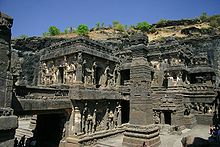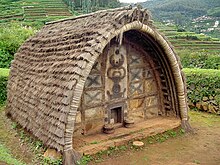Music
The music of India includes multiples varieties of folk, popular, pop, and classical music. India's classical music tradition that originates, has a basis from and is heavily influenced by Hindu texts. It includes Carnatic and Hindustani music and is noted for the use of several Raga, has a history spanning millennia, and, developed over several eras, remains instrumental to the religious inspiration, cultural expression and pure entertainment. Alongside distinctly subcontinental forms, there are major similarities with other types of Oriental music.
Purandaradasa is considered the "father of carnatic music" (Karnataka sangeeta pitamaha).[5][6][7] He concluded his songs with a salutation to Lord Purandara Vittala and is believed to have composed as many as 75,000 - 475,000 songs in the Kannada language. However, only about 1000 are known today.[8][5]
Dance
Indian dance too has diverse folk and classical forms. Among the well-known folk dances are the bhangra of the Punjab, the bihu of Assam, the chhau of Jharkhand and Orissa and the ghoomar of Rajasthan. Eight dance forms, many with narrative forms and mythological elements, have been accorded classical dance status by India's National Academy of Music, Dance, and Drama. These are: bharatanatyam of the state of Tamil Nadu, kathak of Uttar Pradesh, kathakali and mohiniattam of Kerala, kuchipudi of Andhra Pradesh, manipuri of Manipur, odissi of the state of Orissa and the sattriya of Assam.[9]
Drama and theatre
Indian drama and theatre has a long history alongside its music and dance. Kalidas' plays like Shakuntala and Meghadoot are some of the oldest plays from literary traditions. The tradition of folk theatre is alive in nearly all the linguistic regions of the country.[citation needed] In addition, there is a rich tradition of puppet theatre in rural India. Group Theatre is also thriving in the cities, initiated by the likes of Gubbi Veeranna[10] Utpal Dutt, Khwaja Ahmad Abbas, K. V. Subbanna and still maintained by groups like Nandikar, Ninasam and Prithvi Theatre.
Visual arts
Painting
The earliest Indian paintings were the rock paintings of pre-historic times, the petroglyphs as found in places like Bhimbetka, and some of them are older than 550 BC. Ancient texts outline theories of darragh and anecdotal accounts suggesting that it was common for households to paint their doorways or indoor rooms where guests resided.
Cave paintings from Ajanta, Bagh, Ellora and Sittanavasal and temple paintings testify to a love of naturalism and God. Most rock art in India is Hindu or Buddhist. A freshly made coloured flour design (Rangoli) is still a common sight outside the doorstep of many (mostly South Indian) Indian homes.
Madhubani painting, Mysore painting, Rajput painting, Tanjore painting, Mughal painting are some notable Genres of Indian Art; while Raja Ravi Varma, Nandalal Bose, Geeta Vadhera,Jamini Roy and B.Venkatappa[11] are some modern painters. Among the present day artists, Atul Dodiya, Bose Krishnamacnahri, Devajyoti Ray and Shibu Natesan represent a new era of Indian art where global art shows direct amalgamation with Indian classical styles. These artists in recent past acquired international recognition. Devajyoti Ray's paintings have been acquired by the National Fine Arts Museum in Cuba and so have been the works of some of the new generation artists.
Jehangir Art Gallery, Mumbai, Mysore Palace has on display several good Indian paintings.
Sculpture
| This article needs additional citations for verification. Please help improve this article by adding reliable references. Unsourced material may be challenged and removed. (February 2007) |

The first sculptures in India date back to the Indus Valley civilization, where stone and bronze carvings have been discovered. This is one of the earliest instances of sculpture in the world. Later, as Hinduism, Buddhism, and Jainism developed further, India produced some of the most intricate bronzes in the world, as well as unrivalled temple carvings. Some huge shrines, such as the one at Ellora were not actually constructed using blocks, but instead carved out of solid rock, making them perhaps the largest and most intricate sculptures in the world.
The pink sandstone sculptures of Mathura evolved during the Gupta period (4th to 6th century) to reach a very high fineness of execution and delicaracy in the modeling. Newer sculptures in northwest, in stucco, schist, or clay, display very strong blending of Indian post-Gupta mannerism and Classical influence, Hellenistic or possibly even Greco-Roman. Meanwhile, elsewhere in India, less anatomically accurate styles of human representation evolved leading to the classical art that the world is now familiar with and contributing to Buddhist and Hindu sculpture throughout Asia.
Architecture

Indian architecture is that vast tapestry of production of the Indian Subcontinent that encompasses a multitude of expressions over space and time, transformed by the forces of history considered unique to the sub-continent, sometimes destroying, but most of the time absorbing new ideas. The result is an evolving range of architectural production that nonetheless retains a certain amount of continuity across history. The earliest production in the Indus Valley Civilization was characterised by well planned cities and houses where religion did not seem to play an active role, but which demonstrated world-famous city planning.

During the reign of the Gupta and Maurya empires, several Buddhist architectural examples like caves of Ajanta and Ellora and the monumental Sanchi Stupa were built. South India contains several Hindu temples like Chennakesava Temple at Belur, the Hoysaleswara Temple at Halebidu, and the Kesava Temple at Somanathapura, Brihadeeswara Temple, Thanjavur, the Sun Temple, Konark, Sri Ranganathaswamy Temple at Srirangam, and the Buddha stupa (Chinna Lanja dibba and Vikramarka kota dibba) at Bhattiprolu. Angkor Wat and other Buddhist and Hindu temples carry the evidence of Indian influence on South East Asian architecture, as they are built in styles almost identical to traditional Indian temple building.

With the advent of Islamic influence from the west, the erstwhile Indian architecture was slightly adapted to allow the traditions of the new religion. Fatehpur Sikri, Taj Mahal, Gol Gumbaz, Qutub Minar, Red Fort of Delhi are the creations of this era, and are often used as the stereotypical symbols of India, despite the greater antiquity and originality of traditional architecture. The colonial rule of the British Indian Empire saw the development of Indo-Saracenic style, and mixing of several other styles, such as European gothic. Victoria Memorial, Victoria Terminus are notable examples. Recent creations such as Lotus Temple, and the various modern urban developments of India, are also notable.
The traditional system of Vaastu Shastra serves as India's version of Feng Shui, influencing town planning, architecture, and ergonomics. It is unclear which system is older, but they contain many similarities. Although Feng Shui is more commonly used throughout the world.Though Vastu is conceptually similar to Feng Shui in that it also tries to harmonize the flow of energy, (also called life-force or Prana in Sanskrit and Chi/Ki in Chinese/Japanese), through the house, it differs in the details, such as the exact directions in which various objects, rooms, materials etc are to be placed.
Indian architecture has influence the world, especially eastern Asia, due to the spread of ideas with Buddhism. A number of Indian architectural features such as the temple mound or stupa, temple spire or sikhara, temple tower or pagoda and temple gate or torana, have become famous symbols of Asian culture, used extensively in East Asia and South East Asia. The central spire is also sometimes called a vimanam. The variant southern temple gate, or gopuram is noted for its intricacy and majesty. The arch, a cornerstone of world architecture, was first developed by the Indus Valley civilization and would later be a staple of Indian architecture.


